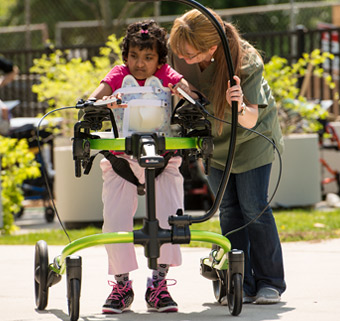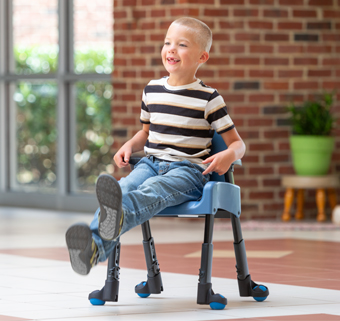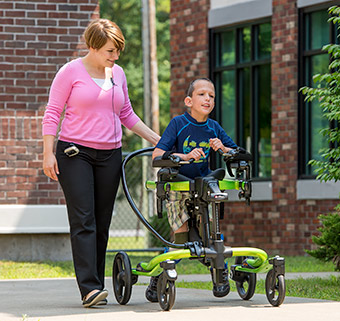Student Achievement in Adapted Physical Education Through Teamwork and Practice
| October 2021 Because every day and each environment present new challenges – adaptation, analysis and flexibility define the world of Adapted Physical Education (APE). I can’t count the number of times I carefully prepared activities and competitions, only to walk into the classroom or gym to find the student sitting in a new wheelchair or (gasp) an old wheelchair. Then there are forgotten trays, new AFOs and no glasses! All these surprises require real-time troubleshooting so our students can be successful.
Because every day and each environment present new challenges – adaptation, analysis and flexibility define the world of Adapted Physical Education (APE). I can’t count the number of times I carefully prepared activities and competitions, only to walk into the classroom or gym to find the student sitting in a new wheelchair or (gasp) an old wheelchair. Then there are forgotten trays, new AFOs and no glasses! All these surprises require real-time troubleshooting so our students can be successful.
Thank goodness for the collaborative team, including the student’s physical therapist, occupational therapist, and instructional and related service providers; because it takes teamwork to see real student achievement. Each discipline provides valuable knowledge and assists with consistent practice in student skills.
Adapted Physical Education Basics
Successful Adapted Physical Education instruction often starts in the classroom. I prefer the Special Education classroom. Here I can limit the distractions and establish successful positioning. First we establish our goal around which all positioning and skill work is built, such as “There’s a Special Olympics competition that looks like a lot of fun for our students.” So as a team, we choose the skills to work on - throwing, kicking or pushing.
Then we begin by working on the skills in each student’s most successful position; for some, it’s side-lying, for others it’s prone over a wedge or sitting. We consider working with (and not against) gravity as a starting point, isolating the parts of the body needed for the movement. For example, for a student with upper extremity weakness who needs to reach out with both hands for a ball at midline, we position a tray under their arms. This minimizes the effort needed to complete the task by eliminating the need to move their hands and arms against gravity in order to put their hand on the ball.
There is a lot of trial and error, and with practice, we usually figure out what works best. I encourage my teachers and parents to help their children practice gross motor and recreation skills at least twice a week. With virtual learning, we have actually seen parents engaging their children in these activities daily. Our students and our families love the opportunity to have a little “normal” fun at home with sports skills and turn-taking.
With good positioning and supplemental support established, we look to the other accommodations necessary for success.
- We may need to implement lightweight equipment to assure success despite motor weakness.
- We can choose targets that are more visually engaging. Using a flashlight to highlight the object is a great strategy to increase visual attention.
- We carefully select specific verbal prompts that we consistently use, keeping all other talking to a minimum.
- For students who need physical assistance, we have found that the hand under hand techniques are best, because tactile modeling is a great way for students to feel and understand a movement.
Structuring the Practice of APE Skills
We begin our practice sessions with as much support as needed for success. The “aha” moment when our student first makes contact with a ball or propels an object is then repeated many times. With practice, the motor pattern becomes more automatic.
The team then switches the focus to supporting generalization of the skill. We analyze what supports need to stay in place and which prompts can be faded. The process is incremental and takes time, but skill mastery eventually happens. This process also gives the team experience with positioning techniques, equipment adjustments and supplemental supports, so when “game day” arrives, the team and the student are more than ready.
Pre-Bocce, Bowling and Basketball Skill Development
Our team witnessed the best example of this process with our student Jason. We problem-solved with Jason for many years, encountering challenges not only due to his unique physical difficulties but also his health issues. We initially positioned him over a wedge to work on reaching out for rain sticks, but because of his GI issues, we had to move him to side-lying so he wouldn’t get sick. During bowling season, he practiced pushing weighted balls across a table top and down ramps made of PVC pipe. His initial goal was to “turn-take” with a friend. He pushed the ball across the ramp to his friend and then “caught” the ball by stopping it on the ramp with one or both hands.
Then, because of Jason’s motivation and our campus-based Special Olympics Basketball Skills competition on the horizon, we thought how to generalize his skills. We implemented a goal to work on “shooting” the basketball, once again by rolling the ball across a ramp.
When schools closed because of COVID, we established a home-based PE routine with equipment loaned from school. Jason’s family got super creative with supplemental supports and worked diligently on the skill of pushing, practicing three to seven times a week. Providing wait time and fading physical prompting resulted in many successful attempts. Over time Jason was able to perform the motor pattern more quickly. From propelling a ball across or down the ramp three to five times within fifteen minutes, he progressed to setting records of fifty times in fifteen minutes. He developed a passion for sports and continued to develop lead-up skills for bocce, bowling, and basketball. We can’t wait for the day he will return to school safely to be included with his peers to participate in the sports skills he loves.
For students with significant disabilities, the journey to the gym begins with consistent practice. Progress is promoted through supported positioning, modified equipment, accommodations and best practice instructional strategies. Competition success is increased when a collaborative team supports students. Students become winners when they are given the opportunity to compete as independently as possible.







